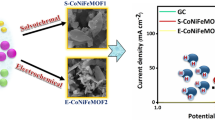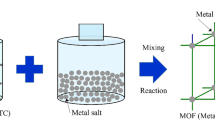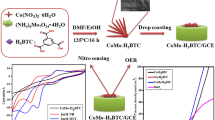Abstract
Metal–organic-frameworks (MOFs) (i.e., MOF(Fe), MOF(Co) and MOF(Cu)) were synthesized by a hydrothermal process. The prepared MOFs were characterized using X-ray diffraction, Fourier transform infrared spectroscopy and N2 adsorption–desorption. The catalytic activities of the MOFs for the electrochemical synthesis of ammonia were evaluated when using N2 (air) and water as raw materials at low temperature and ambient pressure. The results indicated that the prepared MOFs have fine crystalline structures, abundant micropores, and large specific surface areas. The prepared MOFs showed excellent catalytic activity for the electrochemical synthesis of ammonia at low temperature and ambient pressure. Among these MOFs, the MOF(Fe) displayed the best catalytic activity, and the highest ammonia formation rate and the highest current efficiency reached 2.12 × 10−9 mol s−1 cm−2 and 1.43%, respectively, at 1.2 V and 90 °C, when using pure N2 and water as raw materials. The prepared MOFs in this work showed remarkable catalytic activities for the electrochemical synthesis of ammonia at low temperature and ambient pressure among the non-noble metal catalysts. It was the first exploration to apply MOFs as the electrocatalysts for the electrochemical synthesis of ammonia at low temperature and ambient pressure.
Access this article
We’re sorry, something doesn't seem to be working properly.
Please try refreshing the page. If that doesn't work, please contact support so we can address the problem.






Similar content being viewed by others
References
Marnellos G, Stoukides M (1998) Ammonia synthesis at atmospheric pressure. Science 282:98–100
Liu HZ (2014) Ammonia synthesis catalyst 100 years: practice, enlightenment and challenge. Chin J Catal 35:1619–1640
Skodra A, Stoukides M (2009) Electrocatalytic synthesis of ammonia from steam and nitrogen at atmospheric pressure. Solid State Ion 180:1332–1336
Tanabe Y, Nishibayashi Y (2013) Developing more sustainable processes for ammonia synthesis. Coord Chem Rev 257:2551–2564
Lan R, Tao S (2013) Electrochemical synthesis of ammonia directly from air and water using a Li+/H+/NH4 + mixed conducting electrolyte. RSC Adv 3:18016–18021
Giddey S, Badwal SPS, Kulkarni A (2013) Review of electrochemical ammonia production technologies and materials. Int J Hydrog Energy 38:14576–14594
Schrauzer GN, Guth TD (1977) Photolysis of water and photoreduction of nitrogen on titanium-dioxide. J Am Chem Soc 99:7189–7193
Kim J, Rees DC (1992) Crystallographic structure and functional implications of the nitrogenase molybdenum-iron protein from azotobacter vinelandii. Nature 360:553–560
Zhang ZF, Zhong ZP, Liu RQ (2010) Cathode catalysis performance of SmBaCuMO(5+δ) (M = Fe, Co, Ni) in ammonia synthesis. J Rare Earth 28:556–559
Wang Z, Lin J, Wang R, Wei K (2013) Ammonia synthesis over ruthenium catalyst supported on perovskite type BaTiO3. Catal Commun 32:11–14
Brewer AK, Miller RR (1931) The synthesis of ammonia in the low voltage arc. J Am Chem Soc 53:2968–2978
Murakami T, Nishikiori T, Nohira T, Ito Y (2003) Electrolytic synthesis of ammonia in molten salts under atmospheric pressure. J Am Chem Soc 125:334–335
Amar IA, Petit CTG, Mann G, Lan R, Skabara PJ, Tao S (2014) Electrochemical synthesis of ammonia from N2 and H2O based on (Li,Na,K)2CO3-Ce0.8Gd0.18Ca0.02O2−δ composite electrolyte and CoFe2O4 cathode. Int J Hydrog Energy 39:4322–4330
Wang WB, Cao XB, Gao WJ, Zhang F, Wang HT, Ma GL (2010) Ammonia synthesis at atmospheric pressure using a reactor with thin solid electrolyte BaCe0.85Y0.15O3−α membrane. J Membr Sci 360:397–403
Amar IA (2014) Electrochemical synthesis of ammonia from wet nitrogen using La0.6Sr0.4FeO3−δ -Ce0.8Gd0.18Ca0.02O2−δ composite cathode. RSC Adv 4:18749–18754
Vasileiou E, Kyriakou V, Garagounis I, Vourros A, Stoukides M (2015) Ammonia synthesis at atmospheric pressure in a BaCe0.2Zr0.7Y0.1O2.9 solid electrolyte cell. Solid State Ion 275:110–116
You Z, Inazu K, Aika KI, Baba T (2007) Electronic and structural promotion of barium hexaaluminate as a ruthenium catalyst support for ammonia synthesis. J Catal 251:321–331
Xie YH, Wang JD, Liu RQ, Su XT, Sun ZP, Li ZJ (2004) Preparation of La1.9Ca0.1Zr2O6.95 with pyrochlore structure and its application in synthesis of ammonia at atmospheric pressure. Solid State Ion 168:117–121
Liu RQ, Xie YH, Wang JD, Li ZJ, Wang BH (2006) Synthesis of ammonia at atmospheric pressure with Ce0.8M0.2O2−δ (M = La, Y, Gd, Sm) and their proton conduction at intermediate temperature. Solid State Ion 177:73–76
Zhang M, Xu J, Ma G (2011) Proton conduction in BaxCe0.8Y0.2O3−α + 0.04ZnO at intermediate temperatures and its application in ammonia synthesis at atmospheric pressure. J Mater Sci 46:4690–4694. doi:10.1007/s10853-011-5376-0
Cui B, Zhang J, Liu S, Liu X, Xiang W, Liu L et al (2017) Electrochemical synthesis of ammonia directly from N2 and water over iron-based catalysts supported on activated carbon. Green Chem 19:298–304
Li FF, Licht S (2014) Advances in understanding the mechanism and improved stability of the synthesis of ammonia from air and water in hydroxide suspensions of nanoscale Fe2O3. Inorg Chem 53:10042–10044
Liu HZ, Li XN, Hu ZN (1996) Development of novel low temperature and low pressure ammonia synthesis catalyst. Appl Catal A Gen 27:209–222
Yiokari CG, Pitselis GE, Polydoros DG, And ADK, Vayenas CG (2000) High-pressure electrochemical promotion of ammonia synthesis over an industrial iron catalyst. J Phys Chem A 104:10600–10602
Lan R, Alkhazmi KA, Amar IA, Tao S (2014) Synthesis of ammonia directly from wet air at intermediate temperature. Appl Catal B Environ 152:212–217
Rod TH, Logadottir A, Nørskov JK (2000) Ammonia synthesis at low temperatures. J Chem Phys 112:5343–5347
Köleli F, Röpke T (2006) Electrochemical hydrogenation of dinitrogen to ammonia on a polyaniline electrode. Appl Catal. B Environ 62:306–310
Ertl G (1990) Elementary steps in heterogeneous catalysis. Angew Chem Int Ed 29:1219–1227
Lan R, Irvine JT, Tao S (2013) Synthesis of ammonia directly from air and water at ambient temperature and pressure. Sci Rep 3:1–7
Mališ J, Mazúr P, Paidar M et al (2016) Nafion 117 stability under conditions of PEM water electrolysis at elevated temperature and pressure. Int J Hydrog Energy 41:2177–2188
Inoue Y, Kitano M, Kim SW, Yokoyama T, Hara M, Hosono H (2014) Highly dispersed Ru on electride [Ca24Al28O64] +4 (e−)4 as a catalyst for ammonia synthesis. ACS Catal 4:674–680
Kitano M, Inoue Y, Yamazaki Y, Hayashi F, Kanbara S, Matsuishi S et al (2012) Ammonia synthesis using a stable electride as an electron donor and reversible hydrogen store. Nat Chem 4:934–940
Yun DS, Joo JH, Yu JH, Yoon HC, Kim JN, Yoo CY (2015) Electrochemical ammonia synthesis from steam and nitrogen using proton conducting yttrium doped barium zirconate electrolyte with silver, platinum, and lanthanum strontium cobalt ferrite electrocatalyst. J Power Sources 284:245–251
Hasnat MA, Karim MR, Machida M (2009) Electrocatalytic ammonia synthesis: role of cathode materials and reactor configuration. Catal Commun 10:1975–1979
Karolewska M, Truszkiewicz E, Wściseł M, Mierzwa B, Kępiński L, Raróg-Pilecka W (2013) Ammonia synthesis over a Ba and Ce-promoted carbon supported cobalt catalyst. Effect of the cerium addition and preparation procedure. J Catal 303:130–134
Renner JN, Greenlee LF, Ayres KE, Herring AM (2015) Electrochemical synthesis of ammonia: a low pressure, low temperature approach. Electrochem Soc Interface 24:51–57
Tran UPN, Le KKA, Phan NTS (2011) Expanding applications of metal-organic frameworks: zeolite imidazolate framework ZIF-8 as an efficient heterogeneous catalyst for the knoevenagel reaction. ACS Catal 1:120–127
Ranft A, Betzler SB, Haase F et al (2013) Additive-mediated size control of MOF nanoparticles. CrystEngComm 15:9296–9300
Wang H, Yin F, Chen B, Li G (2015) Synthesis of an ε-MnO2/metal-organic-framework composite and its electrocatalysis towards oxygen reduction reaction in an alkaline electrolyte. J Mater Chem A 3:322–335
Hasan Z, Jeon J, Jhung SH (2012) Adsorptive removal of naproxen and clofibric acid from water using metal-organic frameworks. J Hazard Maters 209–210:151–157
Wang H, Yin F, Li G, Chen B, Wang Z (2014) Preparation, characterization and bifunctional catalytic properties of MOF(Fe/Co) catalyst for oxygen reduction/evolution reactions in alkaline electrolyte. Int J Hydrog Energy 39:16179–16186
Qiang RR (2006) The effect of potassium sodium tartrate solutions on ammonia standard curves. Environ Monit China 22:40–41
Guo X, Xing T, Lou Y, Chen J (2015) Controlling ZIF-67 crystals formation through various cobalt sources in aqueous solution. J Solid State Chem 235:107–112
Lan R, Alkhazmi KA, Amar IA, Tao S (2014) Synthesis of ammonia directly from wet air using new perovskite oxide La0.8Cs0.2Fe0.8Ni0.2O3−δ as catalyst. Electrochim Acta 123:582–587
Amar IA, Petit CTG, Zhang L, Lan R, Skabara PJ, Tao S (2011) Electrochemical synthesis of ammonia based on doped-ceria-carbonate composite electrolyte and perovskite cathode. Solid State Ion 201:94–100
Kordali V, Kyriacou G, Lambrou C (2000) Electrochemical synthesis of ammonia at atmospheric pressure and low temperature in a solid polymer electrolyte cell. Chem Commun 17:1673–1674
Dahl S, Logadottir A, Egeberg RC, Larsen JH, Chorkendorff I, Ouml E et al (1999) Role of steps in N2 activation on Ru(0001). Phys Rev Lett 83:1814–1817
Leigh GJ (2002) Protonation of coordinated dinitrogen. Acc Chem Res 25:177–181
Whitman LJ, Bartosch CE, Ho W, Strasser G, Grunze M (1986) Alkali-metal promotion of a dissociation precursor: N2 on Fe(111). Phys Rev Let 56:1984–1987
Aika KI (1995) Ammonia synthesis over non-iron catalysts and related phenomena. Springer, Berlin Heidelberg
Chen Y, Zhou Y, Wang H, Lu J, Uchida T, Xu Q et al (2015) Multifunctional PdAg@MIL-101 for one-pot cascade reactions: combination of host-guest cooperation and bimetallic synergy in catalysis. ACS Catal 5:2062–2069
Vermoortele F, Bueken B, Le Bars G, Van de Voorde B, Vandichel M, Houthoofd K et al (2013) Synthesis modulation as a tool to increase the catalytic activity of metal-organic frameworks: the unique case of UiO-66(Zr). J Am Chem Soc 135:11465–11468
Acknowledgements
We gratefully acknowledge the Natural Science Foundation of China (21276018), the Natural Science Foundation of Jiangsu Province of China (BK20140268 and BK20161200), Fundamental Research Funds for the Central Universities (buctrc201526), Changzhou Sci & Tech Program (CJ20159006 and CJ20160007), and the Advanced Catalysis and Green Manufacturing Collaborative Innovation Centre of Changzhou University (ACGM2016-06-02, ACGM2016-06-03).
Author information
Authors and Affiliations
Corresponding author
Rights and permissions
About this article
Cite this article
Zhao, X., Yin, F., Liu, N. et al. Highly efficient metal–organic-framework catalysts for electrochemical synthesis of ammonia from N2 (air) and water at low temperature and ambient pressure. J Mater Sci 52, 10175–10185 (2017). https://doi.org/10.1007/s10853-017-1176-5
Received:
Accepted:
Published:
Issue Date:
DOI: https://doi.org/10.1007/s10853-017-1176-5




